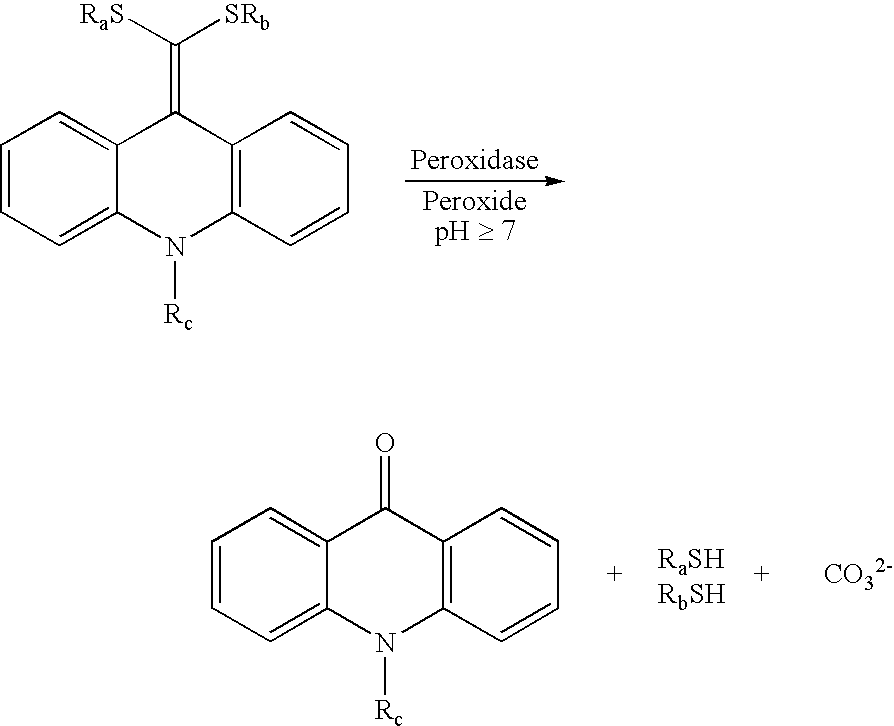Methods of extracting RNA
a technology of ribonucleic acids and extraction methods, which is applied in the field of ribonucleic acids, can solve the problems of complicated clinical use of rna, cumbersome multi-step nature of above methods for isolating rna, etc., and achieve the effect of rapid and simple extraction and isolation
- Summary
- Abstract
- Description
- Claims
- Application Information
AI Technical Summary
Benefits of technology
Problems solved by technology
Method used
Image
Examples
example 1
Solid Phase Material Useful in Isolating RNA
[0074]Synthesis of magnetic particles functionalized with a tributylphosphonium NAB group and a cleavable arylthioester linkage.
[0075]a) Preparation of magnetite. Argon was bubbled through 3 L of type I water in a 5 L flask for one hour. Concentrated NH4OH (28%, 180 mL) was added under Ar. A mixture of 50 mL of 2 M FeCl2 in 1 M HCl and 200 mL of 1 M FeCl3 in 1 M HCl was added via addition funnel over a period of about one hour. The solids were collected in two flasks by pouring 500-600 mL portions into a flask with a disk magnet on the outside, decanting the supernatant each time. The solid was washed by dispersion in 500-600 mL of type I water with sonication followed by attracting to a magnet and decanting the supernatant. The process was repeated until the pH of the supernatant was ca. 8.5. The contents of the two flasks were combined so that the magnetite was stored in a total volume of ca. 500 mL.
[0076]b) A 500 mL flask was charged wi...
example 2
Larger Particle Size Solid Phase Material
[0083]Synthesis of magnetic particles functionalized with a tributylphosphonium NAB group and a cleavable arylthioester linkage.
[0084]a) A 500 mL flask was charged with 3-methylaminopropyltrimethoxysilane (149.8 g) and purged with Ar. After placing the flask in an ice bath, acryloyloxytrimethylsilane (119.6 g) was added slowly via syringe. The reaction was stirred for 5 minutes, the ice bath removed and stirring continued for 2 hours. The product was used without further purification.
[0085]b) Commercial magnetite (Strem cat. No. 93-2616 1-5 μm) 5.0 g was diluted with 140 mL of type I water and 1.25 L of ethanol. Concentrated NH4OH (28%, 170 mL) was added after 30-45 minutes. A solution of 1.5 g of the silyl ester from step b) and 13.5 g of Si(OEt)4 in ethanol was added in three portions to the reaction at 90 minute intervals. A solution of 3.75 g of silyl ester compound in 20-30 mL of ethanol was then added and the mixture stirred and sonicat...
example 3
Synthesis of Functionalized Magnetic Polymer
[0091]
[0092]An aliquot of beads (Dynal magnetic COOH beads, Lot No. G36710) containing 25 mg of solid was decanted by the aid of a magnet. Beads were then washed with 3×1 mL of water, and 3×1 mL CH3CN before drying for 4 hrs. The beads were suspended in 1 mL of CH2Cl2 to which was added 28.8 mg of EDC and shaken for 30 min. A solution of 1,4-benzenedithiol (30 mg) was added to the mixture. The tube was sonicated for 1 min and shaken over night. The supernatant was removed and the beads were washed magnetically with 4×1 mL of CH2Cl2, 1 mL of 1:1 MeOH: CH2Cl2, 4×1 mL of MeOH and 4×1 mL of CH2Cl2.
[0093]The beads were suspended in 1 mL of CH2Cl2to which was added 140 μL of tributylphosphine. The reaction mixture was vortexed for 1 min and shaken for a total of 3 days. The solvent was decanted by keeping on a magnet. Beads were washed magnetically with 4×1 mL of CH2Cl2, 1 mL of 1:1 MeOH: CH2Cl2, 4×1 mL of MeOH, 1 mL of 1:1 MeOH: CH2Cl2, and 4×1...
PUM
| Property | Measurement | Unit |
|---|---|---|
| Diameter | aaaaa | aaaaa |
| Molar density | aaaaa | aaaaa |
| Molar density | aaaaa | aaaaa |
Abstract
Description
Claims
Application Information
 Login to View More
Login to View More - R&D
- Intellectual Property
- Life Sciences
- Materials
- Tech Scout
- Unparalleled Data Quality
- Higher Quality Content
- 60% Fewer Hallucinations
Browse by: Latest US Patents, China's latest patents, Technical Efficacy Thesaurus, Application Domain, Technology Topic, Popular Technical Reports.
© 2025 PatSnap. All rights reserved.Legal|Privacy policy|Modern Slavery Act Transparency Statement|Sitemap|About US| Contact US: help@patsnap.com



